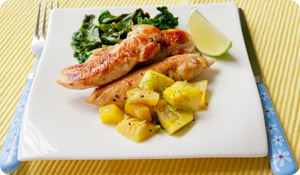
Cataracts and age-related macular degeneration—eye conditions that can cause vision loss—affect more than 22 million Americans over the age of 40, and many more are at risk. But regularly consuming foods with lutein and zeaxanthin, vitamin C, vitamin E, essential fatty acids, and zinc can help lower your risk for cataracts (clouding of the lenses of the eye) and age-related macular degeneration (gradual loss of vision)—and potentially save your vision, according to the American Optometric Association (AOA). Here’s more about these eyesight-preservers:
Lutein and Zeaxanthin
The AOA says that of the 600 carotenoids (antioxidants) found in nature, only two are deposited in high quantities in the eye: lutein and zeaxanthin. These antioxidants filter out harmful high-energy blue light to help protect healthy cells.
You’ll find lutein and zeaxanthin in leafy greens like spinach, turnip greens, kale, and collard, dandelion, and mustard greens. Squash, beans, beet greens, corn, asparagus, Brussels sprouts, broccoli, and egg yolks are also excellent sources.
Meal idea: Try a stir-fry of mixed greens and asparagus topped with chopped hard-cooked egg.
Vitamin C
Studies show that vitamin C (ascorbic acid) lowers the risk of developing cataracts and may slow the progression of age-related macular degeneration and loss of visual acuity (sharpness of vision). It’s easy to get your C with citrus fruits and orange juice, but it’s also present in berries, broccoli, papayas, and cauliflower.
Meal idea: Make a fresh fruit salad or toss some lightly steamed broccoli into your day.
Vitamin E
This vitamin also reduces your chances of developing macular degeneration and cataracts, most likely by protecting cells in the eyes from damage caused by free radicals (unstable molecules) that break down healthy tissue. Vitamin E also boosts the immune system, which works to protect you from disease. The AOA recommends obtaining vitamin E from nuts, fortified cereals, and sweet potatoes. Shrimp, avocados, and peanut butter are also excellent sources.
Meal idea: Serve up a shrimp and avocado salad with a side dish of oven-baked sweet potato fries.
Essential Fatty Acids
Certain healthy fats known as omega-3 fatty acids (specifically DHA and EPA) not only help keep your nervous system, metabolism, and immune system functioning, they’re also particularly important for eye health. Salmon, anchovies and tuna are great sources of essential fatty acids but so are walnuts, soybeans, and tofu.
Meal idea: Snack on a handful of walnuts or add some anchovies to your Caesar salad or pizza—your baby blues will thank you.
Zinc
Zinc is a mineral that helps bring vitamin A from the liver to the retina to produce melanin, a protective pigment in the eyes. Zinc deficiency has been linked to poor night vision and cloudy cataracts. Oysters and beef are great sources of zinc, but so are wheat germ, pumpkin, and squash seeds.
Meal idea: Sprinkle some pumpkin seeds in your salad or choose whole wheat bread to go with your roast beef sandwich.
While food is always the best source for all vitamins and minerals, supplements can deliver eye-healthy nutrients as well. Look for vitamin tablets labeled for eye health and check to see if the nutrients listed above are included. Check with your physician or optometrist if you have any concerns about your eyes, vitamins, or vision.
Liesa Harte, MD, functional medicine specialist and founder, Elite Care, reviewed this article.
Sources
"Diet and Nutrition." American Optometric Association. Accessed March 2014. "Age-Related Macular Degeneration." American Optometric Association.
"Eye & Vision Problems." American Optometric Association.
"Vision Health Initiative (VHI)." Centers for Disease Control and Prevention. Page last updated: April 23, 2013.
Roberts RL, J Green and B Lewin. "Lutein and Zeaxanthin in Eye and Skin Health." Clinics in Dermatology 27 No. 2 (2009): 195-201. doi: 10.1016/j.clindermatol.2008.01.011.





